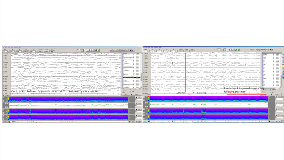Macroperiodic Oscillations (MOs) Precede Recurrent Seizures Following Acquired Brain Injury in Young Children
Abstract number :
2.021
Submission category :
3. Neurophysiology / 3B. ICU EEG
Year :
2018
Submission ID :
501833
Source :
www.aesnet.org
Presentation date :
12/2/2018 4:04:48 PM
Published date :
Nov 5, 2018, 18:00 PM
Authors :
Rejean Guerriero, Washington University in St. Louis; Stuart Tomko, Washington University in St. Louis; Alex Ganniger, Washington University School of Medicine; Kendall Sputo, Washington University in St. Louis; Abu Shamsuzzaman, Washington University Sch
Rationale: Electrographic seizures occur in 10-40 % of critically ill children with most of these being subclinical. Electrographic status epilepticus and high seizure burden are associated with mortality and poor outcomes. Predicting which patients will have the highest seizure burden and the extent to which aggressive treatment is beneficial remains elusive. Quantitative EEG trend analysis is a tool for monitoring critically ill patients and holds potential as an EEG biomarker to monitor patients with a high seizure burden. During clinically indicated monitoring we identified a periodic pattern on digital spectral array (DSA) that oscillates over a time course of 4-5 minutes and is not apparent on the 10-20 second raw EEG tracing. When observed these macroperiodic oscillations (MOs) preceded the appearance of recurrent seizures and status epilepticus (SE). We sought to clinically characterize these subjects compared with other patients monitored during the same period. Methods: We collected demographic and clinical data, including age, sex, reason for admission, premorbid conditions, indication for EEG, and duration and hospital location of monitoring. From October 2015 to February 2018 we identified 40 subjects in either the neonatal, cardiac or pediatric intensive care units (ICUs) with a form of this pattern. We compared these subjects to 381 patients receiving bedside EEG monitoring in the ICUs during the same period. Results: Patients with MOs were younger than patients from the general ICU monitoring population, with a mean age of 1.5 versus 5 years (p < 0.02) and more likely to have an acquired brain injury, including stroke or hemorrhage (22.5 vs. 1.6 %, p < 0.001), TBI (27.5 vs 3.7 %, p < 0.001), and anoxic injury from cardiorespiratory failure (30.0 vs 14.2 %, p < 0.02). Additionally, patients with MOs had restoration of normal state cycling following treatment of the seizures. Conclusions: MOs represent a periodic pattern over a longer time scale than has traditionally been identified with periodic discharges in critically ill patients. This pattern may represent an EEG biomarker for impending SE and recalcitrant seizures, which could provide a window for earlier treatment and seizure prevention, particularly in young patients with acquired brain injuries. Funding: Washington University Institute of Clinical and Translational Sciences grant UL1TR002345 from the National Center for Advancing Translational Sciences (NCATS) of the National Institutes of Health (NIH).

.tmb-.png?Culture=en&sfvrsn=8fbaf67b_0)